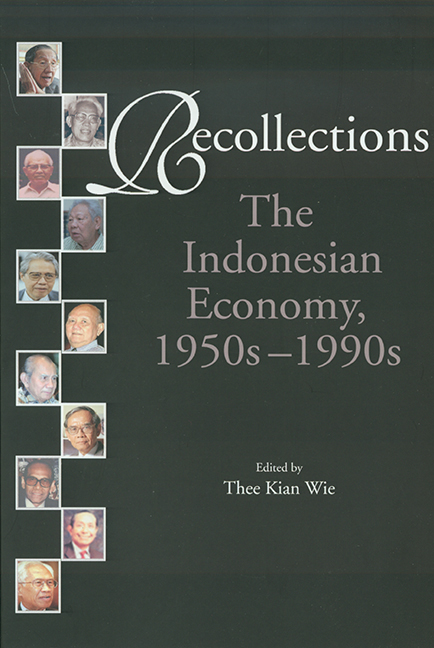Book contents
- Frontmatter
- Dedication
- Contents
- Foreword
- Preface
- Acknowledgments
- Introduction
- II Recollections
- 1 Sumitro Djojohadikusumo
- 2 Mohammad Saubari
- 3 Sjafruddin Prawiranegara
- 4 Abdoel Raoef Soehoed
- 5 Sarbini Sumawinata
- 6 Mohammad Sadli
- 7 Soedarpo Sastrosatomo
- 8 Suhadi Mangkusuwondo
- 9 Emil Salim
- 10 Subroto
- 11 Teuku Mohamad Daud
- Index
- About the Editor
4 - Abdoel Raoef Soehoed
from II - Recollections
Published online by Cambridge University Press: 21 October 2015
- Frontmatter
- Dedication
- Contents
- Foreword
- Preface
- Acknowledgments
- Introduction
- II Recollections
- 1 Sumitro Djojohadikusumo
- 2 Mohammad Saubari
- 3 Sjafruddin Prawiranegara
- 4 Abdoel Raoef Soehoed
- 5 Sarbini Sumawinata
- 6 Mohammad Sadli
- 7 Soedarpo Sastrosatomo
- 8 Suhadi Mangkusuwondo
- 9 Emil Salim
- 10 Subroto
- 11 Teuku Mohamad Daud
- Index
- About the Editor
Summary
THE OLD ORDER
In the Old Order period, I was, as a private businessman, very much involved in industrial development. Very early it had been recognised by the government that the best way to transform the country into an industrialised society is to set up basic industries, although what was meant by basic industries was not clearly defined. As I remember, the Chief of the Planning Board at this time, Ir. Djuanda, proposed a two- pronged approach to industrialisation: (1) industry to produce goods needed in the country, and (2) industry to provide revenues to finance development of other industries; it was a complementary system. Not many of the projects planned during the years before 1965 actually materialised, although there was the first fertiliser plant in Palembang and the first large cement plant in Surabaya, presently known respectively as PT PUSRI and PT Semen Gresik. A steel plant to be built with Russian aid encountered many problems and did not eventuate. There were several plants which were initiated in the Old Order period but stalled because of the political problems around 1965, and were finally completed in the 1970s.
Nevertheless a concept was already adopted, of first setting up basic industries, making use of available natural resources, and then developing downstream industries.
NEW ORDER INDUSTRIAL GROWTH
In the New Order period I believe this concept to be even more valid. Whilst during the Old Order the means were very limited, in the New Order period conditions were different. First of all the new government adopted a policy, which is a very wise one, of opening the country to overseas private capital investment and introducing policies aimed at developing natural resources. In the late 1960s the latter was still limited mainly to oil, owing to financial constraints. By the early 1970s, it was time to develop a long-range strategy, centred on basic industries and natural resources, to be initiated by the government, leaving downstream manufacturing to private enterprise.
- Type
- Chapter
- Information
- RecollectionsThe Indonesian Economy, 1950s–1990s, pp. 87 - 102Publisher: ISEAS–Yusof Ishak InstitutePrint publication year: 2003

